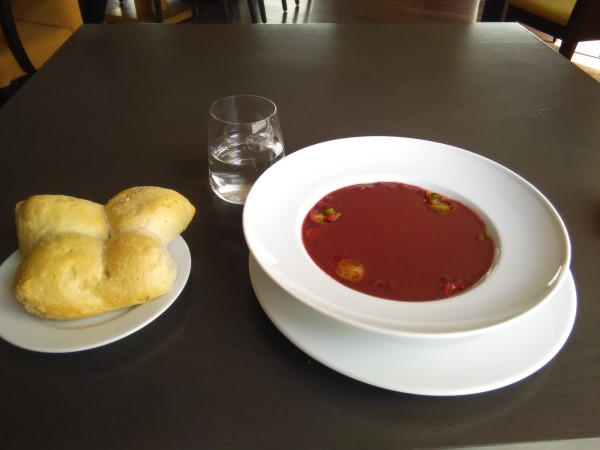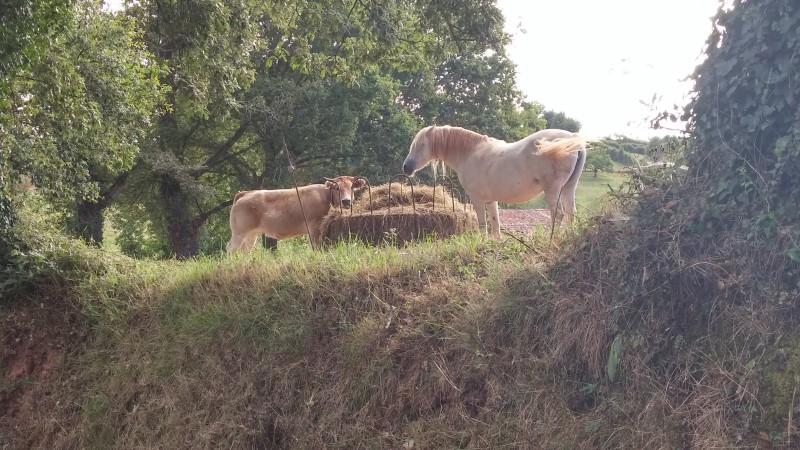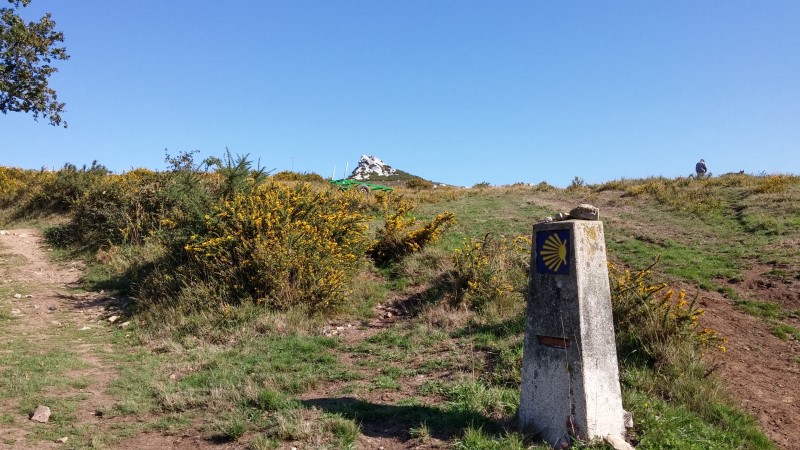Camino Frances, French Camino, or simply “The Camino“. There can always be just one most popular pilgrimage route, and this is the one. Over 215,000 people walked the French way in 2023 alone, which is more than the numbers of pilgrims on all other pilgrimage routes in Spain combined.
This doesn’t necessarily mean it is the best, or the most beautiful Camino. Just like the Oscar winning movies are rarely true artistic masterpieces, or the popular songs that top the charts nowadays rarely have anything to do with quality music… But it is the Camino, the one we all started with, and in this article I will try to find the answer on the best time to walk it. Or, to be more precise, I will explain the specifications, advantages, and disadvantages of walking the French way is different seasons of the year. Let’s dive into this!
Table of Contents
A crucial point to understand about Camino Frances before we start
Before we start analyzing the first season, I want to explain to you something important. Camino Frances passes through different regions of Spain. And these regions vary a lot, in terms of landscape, weather, and culture. That’s why in order to understand what’s the best time to walk the French Camino, one has to understand what it is like in these different parts of the way, in each season.
Now, while some may opt for a division based on provinces (Navarre, La Rioja, Castilla y Leon, and Galicia), I prefer (for the purposes of this topic) divide it the following way:
- Pyrenees and the subsequent hills (mostly la Navarre province)–basically just the first 3-4 days of the way (for the purpose of this article I will call it simply “Pyrenees zone” from now on).
- Vineyards and dirt roads of la Rioja–next 3 to 4 days (from now on only “Vineyards zone”).
- The dry part, including the Meseta–next 12-15 days more or less (from now on only “Meseta zone”).
- A short mountainous part around Foncebadon, Cruz de Ferro, 2-3 days (from now on only “Cruz de Ferro zone”)
- Galicia–last 7-10 days, more or less (from now on “Galicia”).
Each of this zones have a specific climate that changes throughout the year, and may certainly impact your decision to walk in this or that period of the year. The parts also have other characteristics that can help you decide what’s the best time to walk the French way for you. Hence I will touch on these when talking about each of the season. Let’s move to the first season, early spring.

– beautiful Spanish skies, something you will enjoy a lot on the French Camino, be it in the morning, during the day, or at night…
Camino Frances in early spring (March, April)
Early spring is definitely still a low season on Camino Frances. Especially March, but also early April, you won’t meet that many people on any section of Camino Frances. This doesn’t mean that you will be alone on the trails–not by any means… But you will at least have a chance to enjoy a relative solitude on your pilgrimage–if you wish to do so, occasionally or every day. And that’s a kind of luxury that won’t be available to you during the high season :).
Good news is that 90% of all pilgrim hostels on the French way are open from 1st March already. Walking in March or April, you do not have to worry much about whether you’ll get a bed, or whether the place you want to reach is actually already open. Reservations aren’t necessary too, hence if you like to do the pilgrimage the old-school way (less and less common nowadays, especially after the pandemics), simply calling it a day whenever you feel like doing that, without any planning and phone calls to the albergues, this is a great period of the year to walk for you. Perhaps the best one (in this regard).
Speaking about weather, let’s have a look at important facts about each “section” of the way:
- Pyrenees zone–The chances of having high snows in the Pyrenees aren’t as high as they were twenty years ago (yeah, global warming is a real thing and Spain isn’t spared its effects), but it can still happen that there is quite a lot of snow above 1,000 meters, and you won’t be able to cross the Pyrenees on the first day from Saint Jean to Roncesvalles, and will have to take the alternative route. I would say that with the weather in the zone these years, you have about 50/50 chance :). The next two days won’t pose any problems though, since you won’t venture so high anymore. Winds are still very strong though, and temperatures can drop sharply towards the morning, hence ultralight packing for this part of the season isn’t really possible–unless you want to risk quitting your Camino after the first day.
- The vineyards zone–you won’t see any leaves on the grapes yet, and this part of the way definitely doesn’t have the beauty that it has later on, especially in autumn, when the grapes are ripe and their smell penetrates the air. Since the zone is already quite open, it gets pretty chilly in the mornings. It doesn’t rain much more here in spring as it does in other parts of the years though, if that’s your concern.
- The Meseta zone–In general, weather doesn’t change that much in the Meseta year round, in terms of rainfall and stuff. That’s why it is so incredibly dry after all. However, you should get ready for some really chilly mornings (easily 6-8 degrees Celsius) still in March and early April.
- Cruz de Ferro zone–Very windy at this part of the year, but some flowers already start to bloom in these mountains (especially in April), and it isn’t as dry as it is most of the year. To encounter an impassable snow from mid March onward is extremely rare nowadays, close to impossible. Days of rainfall are few, but the temperature is still cold.
- Galicia–More rainy than it is in summer, but less rainy than in winter. Still very green (it remains green all year round), the fog is frequent in spring too. But nothing to worry about walking here in early spring.
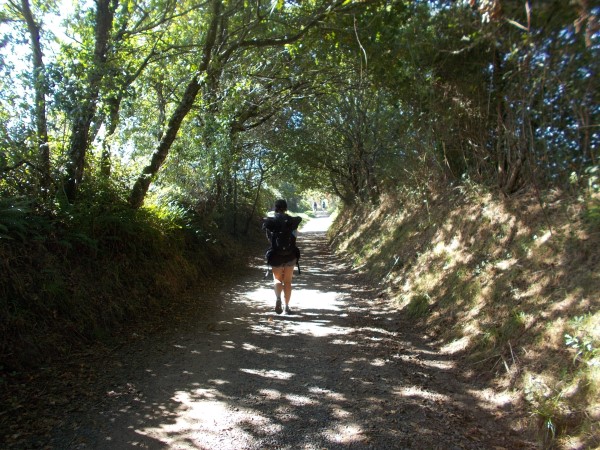

– The “tree tunnels”, typical for Galicia, and green all year round
Walking the Camino Frances in late spring and early summer (May, June)
The months of May and June represent the first high season on Camino Frances. Historically (speaking about last 20-30 years, not the old times pilgrimages of centuries ago), it was a great period to walk the French way, because the heat wasn’t so intense yet, and the route was less crowded than in autumn. However, both of these things are not true anymore, in the last few years.
First of all, with the global warming, June, even early June, is already incredibly hot on the French Camino. This may be fine for you if you just love hot weather and feel good in it, but for many pilgrims it means waking up at 4:30 in the morning and ending their day at noon, because afterwards their body just cannot support the heat and the drought. And secondly, the number of pilgrims on the way is nowadays almost the same in May and June than it is in September and October (another high season on the Camino). Which often means racing for beds, having to make reservations every day, and so on. This is something you should count on.
On the other hand, 100% of pilgrim hostels are open in this period of the year, and the same is true about all restaurants, hotels, facilities, simply everything. You can pack light, because heat will be the problem and not cold, and you will enjoy probably the most variety on the way when it comes to the pilgrims you will meet on your way from Saint Jean to Santiago. As you can see, just like the March/April period, the May/June period has both it’s advantages and disadvantages. Let’s have a look at some weather specifics for the different sections on the way:
- Pyrenees zone–It is the most beautiful in this period of the year, with flowers blooming, everything still green, still benefiting from the winter snows and rains. Perfectly passable.
- The vineyards zone–Much nicer than in March/April, the vines are already nicely green and the ground is red and the skies are beautiful. One feels it is a pleasure to be alive while in this zone
- The Meseta zone–Can already get super hot in the day, it is dry as always. Remember there’s no escape from the sun here, and except of places for pilgrims and the few bigger cities far an between, everything is a ghost town here. If you struggle with heat a lot, you either have to wake up super early on this part of the way, or skip it taking a bus :).
- Cruz de Ferro zone–Super beautiful, still quite green, probably the nicest part of the year to walk this section of the way.
- Galicia–In terms of rain, May and first half of June do not differ much from March and April, it is just a bit warmer. Still green and nice, good for walking.


– A typical path in the La Rioja zone, this picture I took in autumn. Looks much different in late spring, but both seasons have their beauty on this section of the way 🙂
Walking the Camino Frances in summer (July, August)
Summer in Spain. Sun, girls, beer (or wine) and endless evenings in the marvelous country… If this is your idea of a summer pilgrimage on Camino Frances, I have to spoil the party for you. While many people are still on the Camino Frances (though it certainly isn’t the most popular pilgrimage way in July or August), it is often more a fight than a pleasure (which isn’t necessarily a bad thing on a pilgrimage–just saying :)).
What I try to say here is that 80% of the entire distance on Camino Frances is incredibly hot and dry in summer months, and walking in the afternoons isn’t really healthy, or even possible for someone in average shape. That’s why most people doing the French way at this time of a year wake up super early (think 4:30 or even earlier) and end their day before noon. But all infrastructure is still there, and virtually all pilgrim hostels are open (though roughly 2-3% of them tend to close for the summer, the owners heading to the coast to enjoy more favorable weather), so the Camino is still doable.
But I would rather discourage you from trying the Frances in this part of the year. The crowds aren’t as diminished as one would imagine, and when you barely can leave the hostel in the afternoon due to the heat it isn’t probably the kind of experience you are looking for. On the other hand, if you’re into swimming in the few rivers you’ll pass on your way (there’s for example a very nice river area in Molinaseca), this is the time of the year when the water won’t feel too cold.
Some pilgrims play with an idea of waking in the morning, than taking a few hours of siesta, and walking late in the afternoon again, to reach the albergue. There are a few problems about this idea though… First of all, the Spanish sun is so strong, the the difference of temperature and heat at 2pm and 7pm is just minimal. And sure you cannot start walking the “second part of your daily load” at 8pm. And secondly, the pilgrim hostels just do not work this way. Sure, you may make reservations and everything, but the daily regimen in these places simply isn’t set up for people arriving at 10pm… Let’s have a brief look at weather & nature in the five sections of the way:
- Pyrenees zone–Still reasonably green, still some flowers blooming. Not bad by any means. Bear in mind that thunderstorms are very common in summer in this zone. Luckily they typically come at the evening or at night, so they aren’t that much of a concern for the pilgrims.
- The vineyards zone–Still very nice and green, but extremely hot too. There is more shade here than it is in Meseta, but you mostly walk in the open and after 1pm it gets unbearable for most people.
- The Meseta zone–Extremely hard in summer. Most people either take the bus, or walk in early mornings. I even remember a group of Koreans doing Camino Frances in July, and actually walking the Meseta at night, and then sleeping in the hotels during the day (this is possible for Koreans with deep pockets, but it isn’t something for a regular pilgrim).
- Cruz de Ferro zone–Typically already very dry at this point of the year, though you may still see some flowers blooming. Temperature is more favorable due to higher altitude, but the sun is extremely strong anyway.
- Galicia–Nicest weather of the year, with the least rainfall. Galicia isn’t bad in summer, always a bit colder, with plenty of shade, and that’s why probably for the short Camino from Saria to Santiago (the last 100 kilometers) summer isn’t a bad choice. For the whole thing, however (from St. Jean to Santiago) it is a different story…
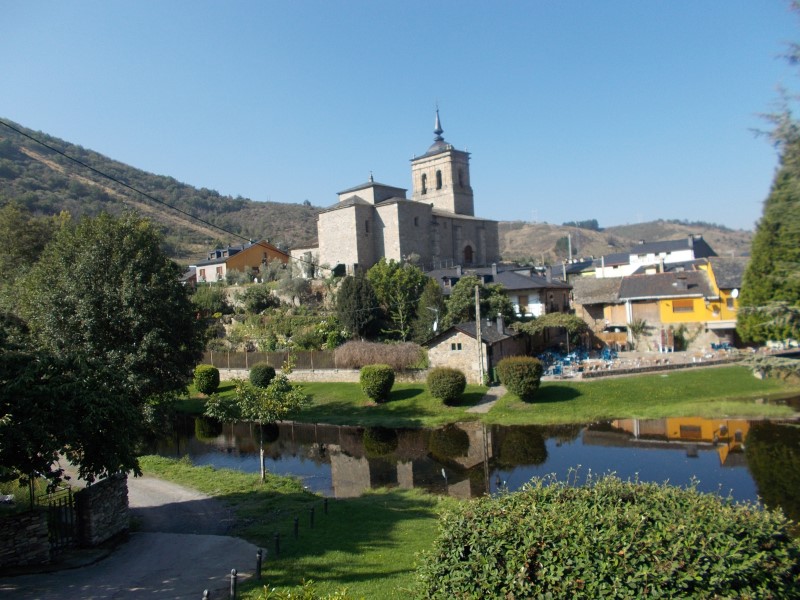

– Molinaseca, with the beautiful river zone. Many pilgrims take a much-needed swim here in the heat of the summer. In my personal opinion it is also one of the most beautiful villages on the entire French Camino.
Walking the Camino Frances in early autumn (September, October)
September and October originally represented the high season on Camino Frances. Sun isn’t so strong anymore at this time of the year, the grapes in La Rioja are ripe to eat, and Galicia is still just moderately rainy. And while all of this is still correct, few things have changed over the recent years. First of all, with the climate change and its impact on Spanish interior, big part of Camino Frances is typically incredibly dry in September and October. The nature just cannot cope with the heat anymore, and more and more of Spanish interior is actually turning to a desert. Camino is no exception to the rule…
What I try to say is that if you want to see the flowers, the trees and bushes green, and have a feeling that there are some birds and life around you, to do the Camino Frances is spring is a much better idea than doing it in autumn. Because in autumn, after the crops have been harvested, everything is incredibly dry on this Camino, almost all the way until Galicia (which is impacted by the Atlantic ocean, and hence sees much more rainfall than other parts of the French way). Now, for some people this can also has its specific beauty. But I just wanted to let you know what to expect :).
In terms of infrastructure, virtually 100% of pilgrim hostels and restaurants along the route are open in both September and October. The way is pretty crowded too… Let’s have a look at some specifications for various parts of the route:
- Pyrenees zone–Less green, but still some grass and tress with leaves and everything. Fog is very common in this part of the year, and hence if you’re unlucky you won’t see much even from the mountain ridge that you cross the first day. Temperature does almost never drop below 3 degrees Celsius, even on the coldest days. Snow is extremely rare, and if you’re lucky to experience a snowfall it will melt away the very next day.
- The vineyards zone–The grape picking season is here, which means that you can ask the workers in the fields for some fresh grapes! Sky in La Rioja has all sorts of beautiful colors in autumn, and the mornings aren’t too chilly yet. Definitely a pleasure to walk this section in autumn.
- The Meseta zone–Much better than it the very heat of summer. There still isn’t any vegetation around, and it is still a hard and for some people also incredibly boring part of the camino, but at least it is easier on the body now.
- Cruz de Ferro zone–Typically already very dry at this point of the year, and no flowers blooming anymore. Things can get a bit better in October, if the zone has enough rainfall, which has a tendency to bring some life back to the vegetation. But this isn’t guaranteed.
- Galicia–The season of chilly foggy mornings has already arrived, but the dreaded Galician winter rainy season has not! And while you won’t see many flowers blooming anymore, Galicia is still definitely full of life in September and October, and makes for a nice climax of your long pilgrimage in Spain.


– Flat and dry meseta in the autumn. Brownish color and clouds that typically never bring any real rain…
Walking the Camino Frances in late autumn and Christmas time (November, December)
Now you may think: Who would walk the Camino in December? That’s Christmas time, people are at home with their families and children, and everything is shut down in Spain. Well, this cannot be farther from the truth. While roughly 30% of pilgrim hostels close for the winter months, 70% remain open, including all public albergues. And secondly, many people live alone nowadays, or their partner has died already, or they simply do not have a family, or they hate Christmas…
One way or another, you can be sure you won’t be alone on the Camino Frances in November and December. The way won’t be crowded anymore, but the infrastructure is still there, and actually some people plan it the way that they want to arrive in Santiago de Compostela at Christmas. Of course, planning the Camino and actually sticking to the plan are two different things (waking injuries, blisters, stretch of very bad weather, falling in love with another pilgrim, and many other things can easily change our plans :)). But the point is that there will always be some pilgrims around in November and December. Let’s have a look at how the different parts of this Camino look and feel during there months:
- Pyrenees zone—Windy, chilly, rainy, and if you have a bit of luck–though it really depends on your perspective :), you’ll have snow on the ridge. If it isn’t some hard snowfall, you can follow the original route. If it is too much snow, you have to take the alternative route. No shame in doing it, because any way that leads to Santiago is the Camino…
- The vineyards zone–The grapes have already been picked, and the vines are bare and looking almost sad down there. It still doesn’t rain that much in the zone, but if the rain comes, it is typically a consistent drizzle. Not too many people around in La Rioja at this time of the year.
- The Meseta zone–Can be actually quite cold and windy too, especially in December. Snow is rare (since there isn’t simply enough precipitation in the Meseta to notice it). The temperature often drops below zero at night, and with the winter sun it takes some time for the ground air to warm up. Not an easy spot to be. Some albergues in the Meseta close in December, which can be an issue, since in certain parts of the Meseta the only infrastructure existing is the infrastructure for pilgrims. There’s nobody else around…
- Cruz de Ferro zone–Can already have decent snowfall in late November and early December. Which makes it kind of nicer. Pilgrim hostels remain open in the zone throughout winter.
- Galicia–November and December are extremely rainy in Galicia. It can rain for weeks on end, and while the rain isn’t typically too strong, it is persistent and you may not see much of sun. To be honest, you have to quite lucky to not see at least 2-3 really rainy days walking in Galicia in November/December. In the period around Christmas you may be quite surprised to see decent number of pilgrims around. Some of them prefer to spend Christmas on the way, and for some it is the only period of the year when they can take two weeks holidays, and hence they head for the Camino…
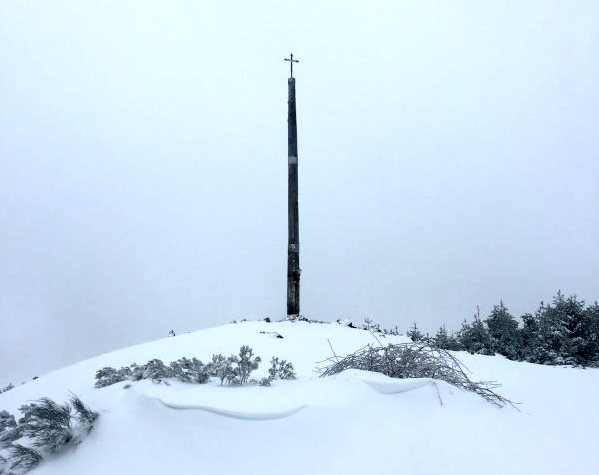

– Snow on Cruz de Ferro. The mountain zone around Foncebadon can get quite a lot of snowfall in the first half of December already, but of course it changes from one year to another.
Walking Camino Frances in plain winter (January, February)
January and February are the true low season on Camino Frances. It is as low as it can get, and even on this most popular pilgrimage route in the whole of Europe, it can happen to you that you barely meet anyone, walking in January and February. Having said that, over two thirds of pilgrim hostels are still open, since they are open year-round. The yellow arrows do not disappear too, and what I try to say here is that you can still walk the Camino.
Prepare for tricky weather throughout though. What many people do not know is that while vast majority of public pilgrim hostels remain open all year long, a big percentage of these does not have functioning heating. That means that while you can stay, the stay resembles more the stay in mountain lodges in Nepal, where you come to the toilet in the middle of the night just to find it frozen :). What I try to say here is that you should get a quality sleeping bag for your winter Camino Frances, and also good water-proof shoes, and basically carry a heavy backpack to make sure the conditions won’t catch you off-guard.
Now you may ask, considering all of this, why would anyone do the Camino in February? Well, life isn’t easy, and sometimes the irresistible calling of the way can conquer a battered pilgrim of life in the midst of winter. And some people like extremes too :). That’s the ego thing of course. But sure enough, if you’ve done Camino Frances all the way from Saint Jean to Santiago in the heights of winter, you have something to talk about on all your other caminos… Let’s have a look at the conditions on various parts of the way:
- Pyrenees zone–Typically covered in snow and impassable. Can be very tricky for navigation too. What’s more, in late January and early February the snow doesn’t cover only the high ridge before Roncesvalles, but also the lower hills you are going to pass on the next days of your Camino in the Navarre province.
- The vineyards zone–Feels almost depressing with the ground frozen and almost no life. The winds also pick up. However, a depressing sensation for one pilgrim can be calming for another, and La Rioja has its subtle beauty in plain winter.
- The Meseta zone–Very cold, and often very windy. You may experience harsh weather with a relatively heavy snowfall, especially in January and the beginning of February. You see, meseta is like a desert, with little to protect you from the elements of nature. If you are unlucky here in January or February, walking over the Meseta can be a true physical and mental challenge.
- Cruz de Ferro zone–Similar to the Meseta, you can experience severe snowfall and severe winds, with the apparent temperature (what it feels like) going below minus 15 degrees on some days. Still, the zone is quite traversed even in winter, that means that even if you have a lot of snowfall you’ll typically find some tracks in front of you, and you can pass.
- Galicia–Very rainy, temperatures around 5-10 degrees. It can rain for weeks on end, but on the other hand each winter there are at least 2-3 weeks of relatively mild weather in Galicia. If you’re very lucky, you can coincide with this stretch, be it at the end of January or in February. As a rule of a thumb though, the weather isn’t very pleasant to walk in Galicia in this period of the year…
Final thoughts on the best time to walk the Camino Frances
I hope that after reading this extensive post you understand that something like the universal best time to walk the French Camino doesn’t exist. Each season has its specifics, and it really depends on what you prefer on the way, in terms of number of pilgrims around you, weather in different sections of the way, infrastructure, daily low and high temperature, and so on. Good news is that you can do the Camino Frances in any month of the year, bearing in mind that you understand what to expect, and prepare accordingly. I wish you best of luck with your decision and see you in Spain ;). Buen Camino!
Matej
May also interest you:


![Ultralight Packing List for Camino de Santiago [2024 Edition]](https://caminolovers.com/wp-content/uploads/2022/03/altra-shoes-640-x-480.jpg)
